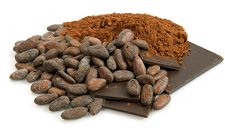Tag Archive: chocolate lessons
Troubleshoot Chocolate Tempering
February 18, 2010
Recently I was asked about tempered chocolate that fails to keep a good shine and what can be done to fix that? (See comments on how to temper chocolate page.)
That's a really good question. Concerns about the streaking and the lack of shine make me think about how temperatures, crystal development and the appearance of chocolate are all connected.
Properly tempered chocolate is shiny and uniform in color. When chocolate has streaks and does not shine, it indicates that at some point in the production process, the chocolate solidified without being in a properly tempered state.
Read more
Chocolate Covered Strawberries
February 2, 2010
Have you ever cut corners while cooking? Ever used short cuts that the original recipe had you make from scratch?
 I have. And why not? Most often those “changes” don’t affect the final product and it saves lots of time. Yes, sometimes I even buy frosting in a can (shhh, don’t tell my kids!).
I have. And why not? Most often those “changes” don’t affect the final product and it saves lots of time. Yes, sometimes I even buy frosting in a can (shhh, don’t tell my kids!).
One thing I have learned from my experience working with chocolate is that there are some short cuts that work and some that don’t.
Read more
Is White Chocolate Really Chocolate?
November 18, 2009
Yes and No.
White chocolate is a blend of cocoa butter, milk, sugar, and vanilla. There is no chocolate liquor (chocolate solids) present, so, can you really call it chocolate? Perhaps not.
However, there is a legal definition for white chocolate to separate it from other “white stuff,” so perhaps yes.
According to U.S. regulations, white chocolate needs to be at least 20% cocoa butter and at least 14% total milk solids.
Beware - there are white chocolate look-a-likes out there!
Read more
Avoid Mistakes While Tempering Chocolate
November 12, 2009
As a follow-up to a few recent posts about tempering chocolate, I thought it might be useful to discuss some common mistakes you might make when tempering.
The most common mistakes I see are the lack of temperature control, lack of proper stirring, not choosing the right chocolate for the job, improper storage, and letting moisture contact the chocolate.
Let’s take a closer look at each of these situations...
Read more
Chocolate Definitions
October 29, 2009
Confusion in the world of chocolate?
You might think, "there’s nothing confusing about chocolate -- you buy it, you eat it!" The reality is, the chocolate world has its own lingo, with terms and definitions that apply to the tasting of chocolate, the baking and cooking of chocolate, and the making of chocolate confections.
 To help you keep it all straight, here is a list of some common chocolate vocabulary along with their definitions...
To help you keep it all straight, here is a list of some common chocolate vocabulary along with their definitions...
Read more
How to Temper Chocolate (Step 2 – Finish)
October 8, 2009
When you buy chocolate in the store, it is already tempered. (At least it should be!) Basically this means it is in a stable solid form at room temperature.
If you want to get down to the business of eating the chocolate straight out of the package, no problem, just break off a chunk and go to it! But, if you want to use the chocolate for any other purpose you may have to re-temper.
This is the final part in my series of tempering chocolate. The first article was about the importance of tempering chocolate. The last article was about melting the chocolate to get ready for tempering.
Read more
How to Temper Chocolate (Step 1 – Melt It)
September 14, 2009
The first step in tempering chocolate is melting the chocolate... Properly!
You might be thinking, what's the big deal about melting chocolate?
Chocolate is a low melting point food. It melts just below human body temperature. While this low melting point means it’s easy to melt in the mouth, it also means it’s easy to burn when direct heat is used. Overheating chocolate will cause it to burn. Burnt chocolate is irreversibly damaged and cannot be used.
In addition to burning, another potential problem when melting chocolate is "seizing". This can happen if you use an indirect heating method like a hot water and a double boiler. Small amounts of water will cause the chocolate to “seize” or become hard and crumbly. Seized chocolate is irreversibly damaged and cannot be used.
The Importance of Tempering Chocolate
August 31, 2009
I admit my mind works differently than that of other chocolate lovers. I am a scientist first, I guess, then a chocolate lover.
One day I was attending a local street festival and happened upon a vendor selling “Fresh Pineapple – Chocolate Covered!” Most people’s first reaction might be, “Yum!” but mine was more like, “Well, this is interesting. It is either a chocolate disaster in the making (there’s too much moisture in most fresh fruit to support a tempered chocolate) or a major discovery!”
Basic Chocolate Tasting
May 28, 2009
Today we're going to quickly explore a method for tasting chocolate. I'd like you to have two chocolate bars ready. These should both be milk chocolate bars or both dark chocolate bars. You can pick different brands or pick the same brand with different percentages of chocolate content. We want to make sure you'll taste sufficient differences.
Now that you have your chocolate ready, you'll need to pick an appropriate time and place to do the tasting. Well, I'm not really sure there's a bad time or place to eat chocolate, but some times and places are better than others to experience the best results.
Read more

